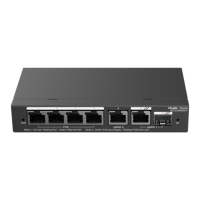After the switch convert mode virtual command is run, the software automatically backs up
the configuration file in the standalone mode as standalone.text, removes the configuration file
config.text, prompts the user to decide whether to overwrite config.text with
virtual_switch.text, write related configurations of VSU in config_vsu_dat, and finally restarts
the switch.
After the switch convert mode standalone command is run, the master device backs up the
configuration file in the VSU mode as virtual_switch.text, removes the configuration file
config.text, prompts the user to decide whether to overwrite config.text with standalone.text,
writes related configurations of VSU in config_vsu_dat, and finally restarts the switch.
This command can be executed in both the standalone and VSU modes. If the command is run
in the standalone mode, the current device performs the standalone/VSU mode handover. If the
command contains a switch ID and is run in the VSU mode, the switch with the ID performs the
standalone/VSU mode handover. If the command does not contain a switch ID, the master
device performs a handover. It is advised to perform standalone/VSU mode handover on the
slave device and then on the master device.
#In the standalone mode, configure the domain ID to 1, the switch ID to 1 and the switch priority to
200 and then convert the switch from standalone mode to VSU mode.
Ruijie(config)# switch virtual domain
1
Ruijie(config-vs-domain)# switch
1
Ruijie(config-vs-domain)# switch
1
priority
200
Ruijie(config-vs-domain)# end
Ruijie# switch convert mode virtual
#In the VSU mode, convert the slave device (The sw_id is 2) to the standalone mode and then
convert the master device (The sw_id is 1) to the standalone mode.
Ruijie# switch convert mode standlone 2
Ruijie# switch convert mode standlone 1

